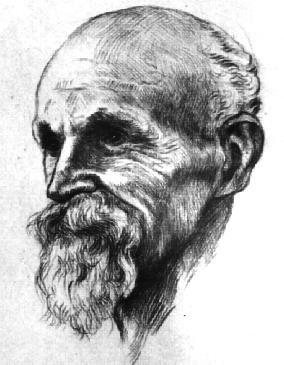Astronomy Bio...John Brashear
Jay Bitterman

John Alfred Brashear was born on Nov. 24, 1840 in Brownsville, Pennsylvania, the son of B.B. and Julia B. Brashear. He only had a public school education. From school he became an apprentice to a machinist and at the age of 20 became a master of the trade. In 1861 he went to Pittsburgh and found employment. In Pittsburgh Brashear married Miss Phoebe Stewart and the young couple planned ways and means for him to study astronomy. For the next 20 years he worked as a mechanic in a steel mill. In the meantime he broadened his elementary knowledge of astronomy and made amateur telescopes in his spare time. In 1870 Brashear built his first telescope in his South Side home and immediately opened his doors to neighbors, friends and strangers to observe the sky.
Dr. Samuel Pierpont Langley, the director of the Allegheny Observatory, encouraged him to establish a workshop for astronomical instruments. The workshop became the John Brashear Co. and later the Contraves Corp., an internationally known maker of superb optics. He built many instruments that included spectroscopes for the observatories at Allegheny, Lick, Yerkes and Princeton, G. E. Hale's first spectroheliograph and two photographic optics for Max Wolf in Heidelberg. The largest mirror made by the John A. Brashear Company was the 72-inch mirror for the Dominion Observatory in Canada.
Brashear telescopes are still in use worldwide. They include two in public observatories in the Pittsburgh area. The 11-inch Brashear refractor telescope at the Nicholas E. Wagman Observatory that is operated by the Amateur Astronomers Association of Pittsburgh, (commissioned by Andrew Carnegie, so students at Carnegie Technical Schools, now Carnegie-Mellon University, could observe Halley's Comet in 1910). The 4-inch Brashear refractor telescope (circa 1900) at the Henry Buhl, Jr. Planetarium and Observatory of The Carnegie Science Center was donated by Mr. J.K. Foster in October 16, 1972; it was the 37th telescope produced by the John Brashear Company.
John Brashear served as acting director of Pittsburgh's Allegheny Observatory that was then located on the campus of the Western University of Pennsylvania. He was also acting chancellor of the Western University of Pennsylvania (now, the University of Pittsburgh), a life trustee of Carnegie Institute, and a member of the three-man Plan and Scope Committee which set-up the Carnegie Technical Schools (now Carnegie-Mellon University). He was associated with many of Pittsburgh's captains of industry including Andrew Carnegie, Henry Clay Frick, George Westinghouse, William Thaw, and Henry Phipps.
Due to his love of people, especially children, most everyone knew him as "Uncle John." More than eight decades after his death, Brashear's spirit lives on with the Amateur Astronomers Association of Pittsburgh. In 1993 the AAAP unanimously approved the naming of Brashear as an honorary member, posthumously. It is the first time since the AAAP that was organized in 1929 that a person was bestowed an honorary membership after his death. In 1994 the AAAP officially named its historic telescope "The Brashear 11-inch Refractor" in honor of "Uncle John". It is the only telescope made entirely by his hands. In his later years he received many honorary degrees from the world's most respected universities and scientific societies in recognition of his skills, innovations and construction of precision astronomical equipment.
Brashear died in April 1920. His remains and those of his wife Phoebe are interred in a crypt beneath the Keeler Memorial Reflecting Telescope at Allegheny Observatory in Pittsburgh's Riverview Park. The epitaph on the Brashears' spaces reads: "We have loved the stars too fondly to be fearful of the night." This line came from the poem; "The Old Astronomer to His Pupil," by Sarah Williams, which John Brashear and his wife both loved. The following is an excerpt from that poem.
"Reach me down my Tycho Brahe,
I would know him when we meet...
Though my soul may set in darkness,
it will rise in perfect light;
I have loved the stars too fondly
to be fearful of the night."





